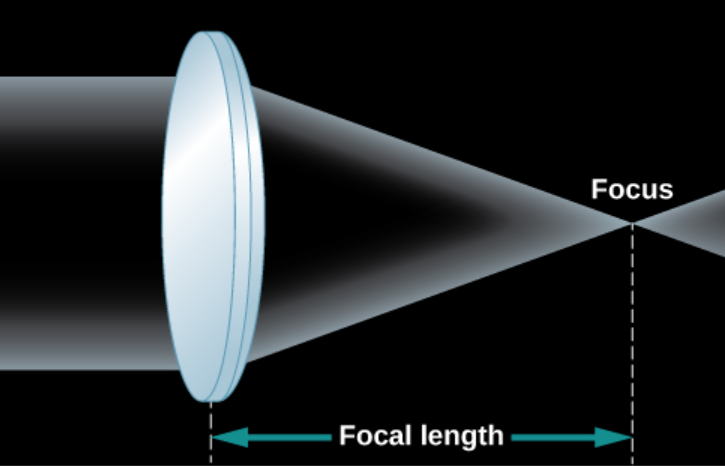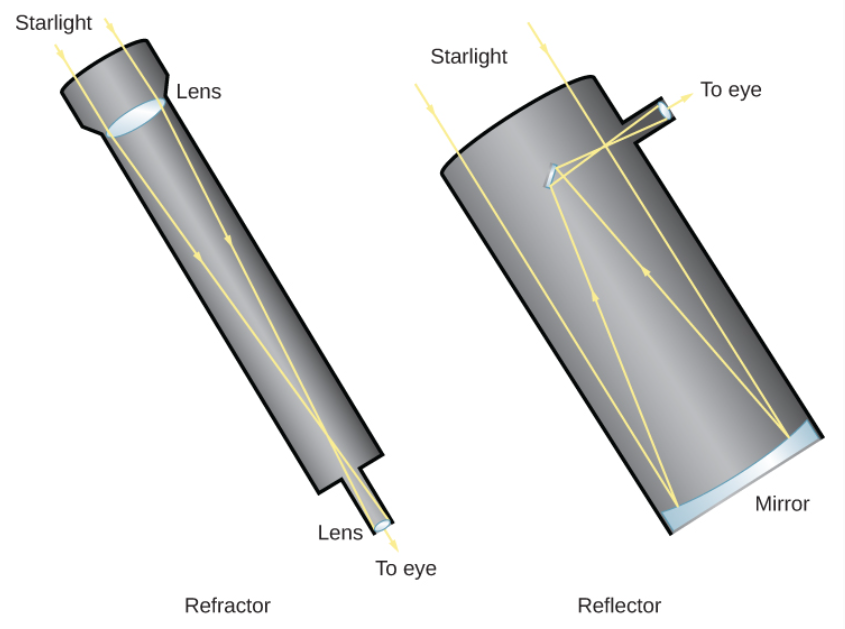chapter 6.1 telescopes & 6.2 telescopes today
1/10
There's no tags or description
Looks like no tags are added yet.
Name | Mastery | Learn | Test | Matching | Spaced |
|---|
No study sessions yet.
11 Terms
three components of a modern system for measuring radiation from astronomical sources
telescope: collects visible light (or radiation of other lengths)
there is an instrument attached to the telescope that sorts the incoming radiation by wavelength
detector: a device that sense the radiation in the wavelength regions we have chosen and permanently records the observations
functions of a telescope
to collect the faint light from an astronomical source
to focus all the light into a point or an image
telescopes that collect visible radiation use a lens or mirror to gather the light
Since most telescopes have mirrors or lenses, we can compare their light-gathering power by comparing the apertures, or diameters, of the opening through which light travels or reflects.
light collected by a telescope
The amount of light a telescope can collect increases with the size of the aperture
A telescope with a mirror that is 4 meters in diameter can collect 16 times as much light as a telescope that is 1 meter in diameter.
The diameter is squared because the area of a circle equals πd2/4, where d is the diameter of the circle
lens
transparent piece of material that bends the rays of light passing through it
if the light rays are parallel as they enter, the lens brings them together in on eplace to form an image
if the curvatures of the lens surfaces are just right, all parallel rays of light are bent, or refracted, in such a way that they converge toward a point, called the focus of the lens
a the focus, an image of the light source appears
in the case of parallel light rays, the distance from the lens to the location where the light rays focus, or image, behind the lens is called the focal length of the lens

eyepiece
used to view the image formed by the lens in a telescope
different eyepieces change the magnification (or size) of the image
refracting telescope
long tube with a large glass lens at one end
the lens is its main optical element to form the image
the light must pass through the lens of a refractor (the glass must be perfect throughout)
Also, optical properties of transparent materials change a little bit with the wavelengths (or colors) of light, so there is some additional distortion, known as chromatic aberration
Each wavelength focuses at a slightly different spot, causing the image to appear blurry
In addition, since the light must pass through the lens, the lens can only be supported around its edges (just like the frames of our eyeglasses).
The force of gravity will cause a large lens to sag and distort the path of the light rays as they pass through it.
Finally, because the light passes through it, both sides of the lens must be manufactured to precisely the right shape in order to produce a sharp image.

concave primary mirror telescope
curved mirror
reflects light to form an image
coated with a shiny metal
If the mirror has the correct shape, all parallel rays are reflected back to the same point, the focus of the mirror
Thus, images are produced by a mirror exactly as they are by a lens
reflecting telescope
uses a mirror not a lens
concave mirror is palced at the bottom of a tube or open framework
prime focus: the mirror reflects light back up the tube to form an image near the front end at a location
how does air impose limitations on the usefulness of a telescope?
The most obvious limitation is weather conditions such as clouds, wind, and rain. At the best sites, the weather is clear as much as 75% of the time.
Even on a clear night, the atmosphere filters out a certain amount of starlight, especially in the infrared, where the absorption is due primarily to water vapor. Astronomers therefore prefer dry sites, generally found at high altitudes.
The sky above the telescope should be dark. Near cities, the air scatters the glare from lights, producing an illumination that hides the faintest stars and limits the distances that can be probed by telescopes. (Astronomers call this effect light pollution.) Observatories are best located at least 100 miles from the nearest large city.
Finally, the air is often unsteady; light passing through this turbulent air is disturbed, resulting in blurred star images. Astronomers call these effects “bad seeing.” When seeing is bad, images of celestial objects are distorted by the constant twisting and bending of light rays by turbulent air.
resolution
the precision of detail present in an image
the smallest features that can be distinguished
one feature that determines how good the resolution is is the size
measured in units of angle on the sky (units of arcseconds)
one arcsecond is 1/3600 degree, and there are 360 degrees in a full circle
adaptive optics
beats Earth’s atmospheric blurring
most effective in the infrared region
makes use of a small flexible mirror placed in the beam of the telescope
With adaptive optics, ground-based telescopes can achieve resolutions of 0.1 arcsecond or a little better in the infrared region of the spectrum